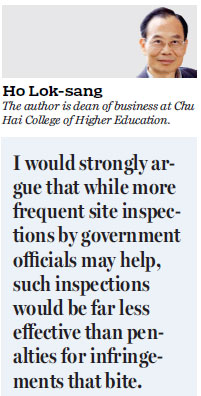Construction site deaths a mark against safety record
Updated: 2017-04-11 07:55
By Ho Lok-sang(HK Edition)
|
|||||||
Ho Lok-sang believes pressure to complete projects on schedule causes fatalities; therefore, penalties for deadly accidents should match those imposed for project delays
Industrial accidents on construction sites have been on the increase, even though the trend of industrial accidents throughout Hong Kong has been downward. According to Hong Kong's Occupational Safety and Health Statistics released by the Labour Department, the rate of injury per 1,000 employees per year has fallen from almost 18 to about 13 between the years 2006 and 2015. This improvement is encouraging and shows that government efforts in promoting industrial safety have borne fruit.
Yet industrial accidents on construction sites have not come down. A newspaper headline in 2014 read: "Number of workers falling to death in Hong Kong hits 10-year high". The subheading read: "Government figures show fatal falls at highest level since 2003." There were a total of 3,863 injuries in the construction industry in 2015, up from 3,573 in the previous year. There were 43 fatalities in 2015, up from 38 in 2014. The complete 2016 numbers are still not available but for the first three quarters, construction industry injuries were up 0.7 percent while those in other industries continued to fall. Confirmed occupational disease incidents inclusive of monaural hearing loss were up 37.5 percent. Monaural hearing loss is usually associated with work on construction sites. The more recent news, again relating to construction, is even more depressing. Sadly, in the section of the Hong Kong-Zhuhai-Macao Bridge (HZMB) construction which we are responsible for, already 10 workers' lives have been lost.
Why are construction sites so dangerous? Must they be this dangerous? It is nice to know that actually construction sites can be safe, but not so nice to know that even though construction sites can be safe, our construction sites are dangerous.

According to some reports, contractors were under tremendous pressure to rush the work on the HZMB, as one day of delay could lead to a penalty of HK$30 million ($3.86 million) per day. In the rush, inadequate attention was paid to the safety of workers.
It was also said that the construction site was rather remote. Since experienced workers have a choice of working at more convenient locations, the percentage of inexperienced workers is rather high on the HZMB project. Inexperienced workers are known to be more accident-prone.
Thus, labor shortage is very much a factor behind the high accident rate on the bridge. But, if construction sites are so dangerous, it will be unlikely for parents to consent to having their children work as construction workers. So a vicious circle could be occurring. I have argued in a recent study on Hong Kong's long-term competitiveness that reducing industrial accidents is necessary if the construction industry is to attract new workers.
Another important factor behind the high incidence of fatal accidents on Hong Kong's construction sites is that the penalty for negligence is much too light, and in particular that Hong Kong does not impose a penalty commensurate with the gravity of the loss of life. The lack of a heavy penalty on loss of life is particularly inexcusable, given the high penalty for completion delays.
If one day of delay in the completion of a work would elicit HK$30 million, the loss of one life should at least require a penalty of HK$30 million. Otherwise, the incentive of the contractor will be to prefer fatal industrial accidents to work delay.
In principle, the greater the penalty for delay, the greater should be the penalty for industrial accidents, particularly for fatalities.
Such high penalties will likely raise the cost of the project. But if the cost is raised we will still have to face it. In principle, if the benefits are too small to justify the high cost of the project, perhaps the project itself is not worthwhile in the first place.
On the other hand, if the project is under really good management, it may be possible that these costs be avoided. Very often, the lack of the appropriate safety measures is just due to an oversight, which in turn is due to laziness. A truly heavy penalty for fatalities will make the project managers wake up to the need to take all the necessary precautions.
According to the mainland authorities, the project managers for the Qinghai-Tibet Railway, which was a most challenging project given its high altitude and thus very dangerous for workers, were able to achieve a record of zero construction worker fatalities due to altitude sickness. The railway from Golmud to Lhasa was completed on Oct 12, 2005, and it opened in 2006.
If the mainland's project managers can do it, why can't Hong Kong's? I would strongly argue that while more frequent site inspections by government officials may help, such inspections would be far less effective than penalties for infringements that bite.
(HK Edition 04/11/2017 page8)